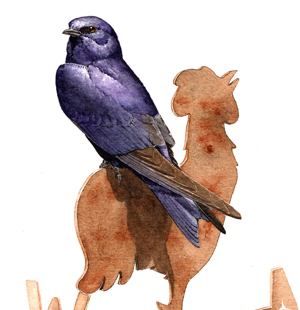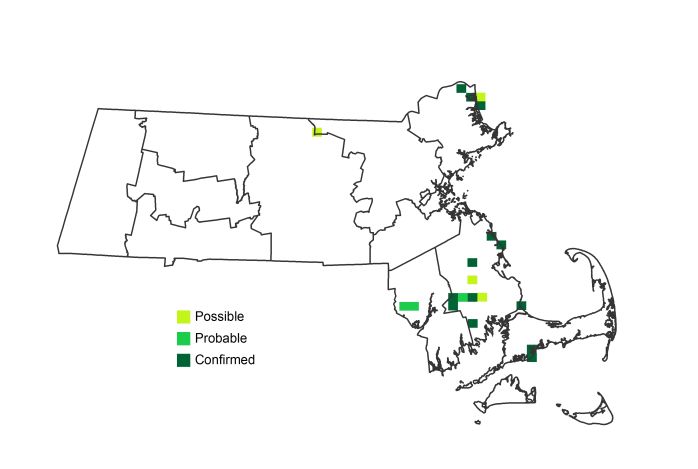Find a Bird
Purple Martin
Progne subis

Very local and strongly declining
Conservation action urgent

“Twirl on, you and your satin blue. / Be water birds, be air birds. / Be these purple tumblers you are.” – Carl Sandburg, “Purple Martins”
Purple Martins were once familiar and much-beloved denizens of many a town and village in eastern Massachusetts. These large and vigorous swallows nest colonially in fanciful multiple-occupancy dwellings erected for them by their human admirers. What many people fail to appreciate is that these birds once lived a very different lifestyle in the wild, and that their relationship with humanity is not so much one of happy symbiosis as one of dependency born of need.
Historic Status
Oral tradition suggests that Purple Martins arrived in New England just prior to the outbreak of the American Revolution, but they can certainly be documented as being in Massachusetts by the 1830s. “So great a favorite is he,” said William Peabody in a report to the state legislature, “that lodgings are provided for him, by the northern farmer, by the southern slave, and even by the Indian, who puts up a calabash for him at his cabin door; not wholly from benevolence, but because the martin pays rent, by keeping insects from the deerskins and venison, exposed in the air to dry” (Peabody 1839). Close to the northern edge of its range in northern New England, the species has always suffered seemingly tragic population swings when multiple-day spring storms sweep through the region. Along with the introduction of House Sparrows and European Starlings, a terrible June 1903 storm brought this species close to extirpation near the beginning of the twentieth century (Forbush 1929).
Atlas 1 Distribution
Purple Martins were found breeding only in the easternmost regions of the state. At that time, practically all of the Coastal Plains records were crowded around Parker River National Wildlife Refuge and its immediate surroundings, which continued to offer the protected salt marsh and open field habitat where martins seem to flourish. 12% of the Bristol/Narragansett Lowlands supported a concentration of colony sites, many of which were on private land. During the time of Atlas 1, the few Confirmed breeding locations on Cape Cod, along with a single Confirmation on Martha’s Vineyard, underscored the species’ complete dependence on humans to provide suitable nesting habitat.
Atlas 2 Distribution and Change
Although one can hardly define as a “devastating crash” the fall from 3% coverage of the state to 2%, the Purple Martin picture in Massachusetts is nonetheless clear. The species had two strongholds in the state: Essex County, specifically the historic breeding centers around Parker River National Wildlife Refuge, where it remained fairly stable; and the southeast. The latter region showed diminishing returns in Atlas 2. In the Bristol/Narragansett Lowlands, Purple Martins suffered a net loss of 4 blocks when comparing the best-surveyed blocks. On Cape Cod and the Islands, the birds returned to only 4 of their 14 Atlas 1 blocks, and showed no new occupancy in the best-covered blocks.
Atlas 1 Map

Atlas 2 Map

Atlas Change Map

Ecoregion Data
Atlas 1 | Atlas 2 | Change | ||||||
Ecoregion | # Blocks | % Blocks | % of Range | # Blocks | % Blocks | % of Range | Change in # Blocks | Change in % Blocks |
Taconic Mountains | 0 | 0.0 | 0.0 | 0 | 0.0 | 0.0 | 0 | 0.0 |
Marble Valleys/Housatonic Valley | 0 | 0.0 | 0.0 | 0 | 0.0 | 0.0 | 0 | 0.0 |
Berkshire Highlands | 0 | 0.0 | 0.0 | 0 | 0.0 | 0.0 | 0 | 0.0 |
Lower Berkshire Hills | 0 | 0.0 | 0.0 | 0 | 0.0 | 0.0 | 0 | 0.0 |
Vermont Piedmont | 0 | 0.0 | 0.0 | 0 | 0.0 | 0.0 | 0 | 0.0 |
Berkshire Transition | 0 | 0.0 | 0.0 | 0 | 0.0 | 0.0 | 0 | 0.0 |
Connecticut River Valley | 0 | 0.0 | 0.0 | 0 | 0.0 | 0.0 | 0 | 0.0 |
Worcester Plateau | 0 | 0.0 | 0.0 | 1 | 1.1 | 5.0 | 0 | 0.0 |
Lower Worcester Plateau | 0 | 0.0 | 0.0 | 0 | 0.0 | 0.0 | 0 | 0.0 |
S. New England Coastal Plains and Hills | 6 | 2.2 | 18.2 | 6 | 2.1 | 30.0 | -1 | -0.4 |
Boston Basin | 0 | 0.0 | 0.0 | 0 | 0.0 | 0.0 | 0 | 0.0 |
Bristol and Narragansett Lowlands | 13 | 12.3 | 39.4 | 9 | 7.9 | 45.0 | -4 | -4.0 |
Cape Cod and Islands | 14 | 10.3 | 42.4 | 4 | 2.8 | 20.0 | -9 | -7.5 |
Statewide Total | 33 | 3.4 | 100.0 | 20 | 1.9 | 100.0 | -14 | -1.7 |
Notes
The Purple Martin shows a significant increasing Breeding Bird Survey (BBS) trend in Massachusetts, but a significant decreasing BBS trend in the eastern US region.



